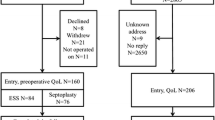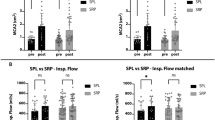Abstract
Objective
The purpose of the study was to analyze the patient’s satisfaction following nasal septal surgery based on their subjective opinion and to study whether the SNOT-22 can be used as a reliable outcome measure for successful septal surgery.
Study design
Between Oct 2005–July 2007, sixty consecutive adult patients who underwent nasal septal surgery and met the study criterion were enrolled. The patients were asked to fill in the SNOT-22 questionnaire both prior to and at regular follow up periods after the surgery.
Results
The mean total preoperative SNOT score (of all 22 items) was 20.67 and the mean total postoperative SNOT-22 score was 10.48 (t = 8.8135, p < 0.001 highly significant). On further analysis, improvement was seen in subcategories of Nasal Symptoms (t = 8.0825, p < 0.001 highly significant), Non Nasal Symptoms (t = 3.0913, p < 0.0025 significant), General health symptoms (t = 4.8602, p < 0.001 highly significant) and Nasal Obstruction (t = 7.7652, p < 0.001 highly significant).
Conclusion
The SNOT-22 score is a useful and reliable tool in nasal septal surgery in that it combines both nasal specific and quality of life related questions, which can be assessed individually and together both pre and post operatively.
Similar content being viewed by others
References
Sipila J and Suonjaa J (1997) A prospective study using rhinomanometry and patient clinical satisfaction to determine if objective measurements of nasal airway resistance can improve the quality of septoplasty. European Archives of Otorhinolaryngology 254:387–390
Shermen L and Hamburg R (1997) Preoperative and postoperative nasal septal surgery assessment with acoustic rhinometry. Otolaryngology Head and Neck Surgery 117:338–342
Reber M, Rahm F, Monnier P (1998) The role of acoustic rhinometry in the pre and postoperative evaluation of results for nasal obstruction. Rhinology 36(4):184–187
Arunachalam PS, Kitcher E, Gray J, Wilson JA (2001) Nasal septal surgery: Evaluation of symptomatic and general health outcomes. Clinical Otolaryngology 26:367–370
Anderson FR, Murphy MP, Weymuller ER (1999) Clinimetric evaluation of the Sinonasal Outcome Test-16. Otolaryngology Head and Neck Surgery 14:702–707
Buckland JR, Thomas S, Harries PG (2003) Can the Sinonasal Outcome Test (SNOT-22) be used as a reliable outcome measure for successful septal surgery? Clinical Otolaryngology 28:43–47
Dinis PB and Haider H (2002) Septoplasty: Long term evaluation of results. American Journal of Otolaryngology 23(2):85–90
Stewart MG, Smith TL, Weaver EM, Witsell DL, Yueh B, Hannley MT et al. (2004) Outcomes after nasal septoplasty: Results from the Nasal Obstruction Septoplasty Effectiveness (NOSE) Study. Otolaryngology Head and Neck Surgery 130:283–290
Robinson K, Gatehouse S, Browning G (1996) Measuring patient benefits from Otolaryngological surgery and therapy. Annals of Otology, Rhinology and Laryngology 105:415–422
Denholm SW, Sim DW, Sanderson RJ (1993) Otolaryngological indicator operations: One year’s experience. Journal of Royal College of Surgeons (Edinburgh) 38(1):1–3
Samad I, Stevens HE, Maloney A (1992) The efficacy of nasal septal surgery. Journal of Otolaryngology 21(2):88–91
Haraldson PO, Nordemar H, Anggard A (1987) Long term results after septal surgery. Submucous resection versus septoplasty. Journal of Otorhinolaryngology and its Related Specialities 49:218–222
Matthias F, Rasp Gerd, Kastenbaurer Ernst (2003) Health-related quality of life in Rhino Surgery. American Journal of Otolaryngology 24:97–105
Jesses M, Ivaesson A, Malm L (1989) Nasal airway resistance and symptoms after functional septoplasty: comparison of findings at 9 months and 9 years. Clinical Otolaryngology 14:231–234
Bohlin L and Dahlqvist A (1994) Nasal airway, resistance and complications following functional septoplasty: a ten year follow-up study. Rhinology 32(4):195–197
Wai-Kuen HO, Anthony P, Yuen W, Tang Kwong-Chi, William I, Paul K, Lam Y (2004) Time course in the relief of nasal blockage after septal and turbinate surgery. Archives of Otolaryngology Head and Neck Surgery 130:324–328
Author information
Authors and Affiliations
Rights and permissions
About this article
Cite this article
Pannu, K.K., Chadha, S. & Kaur, I.p. Evaluation of benefits of nasal septal surgery on nasal symptoms and general health. Indian J Otolaryngol Head Neck Surg 61, 59–65 (2009). https://doi.org/10.1007/s12070-009-0036-2
Published:
Issue Date:
DOI: https://doi.org/10.1007/s12070-009-0036-2




